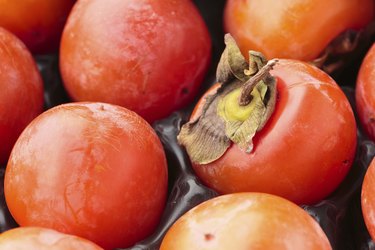
The national fruit of Japan -- the persimmon -- doesn't come with eating instructions, but it should. For the uninitiated, eating a persimmon can be a positive or an altogether unpleasant experience -- depending on the type you choose. Persimmons, which resemble tomatoes with an overgrown flower-like leafy top, range in hue from golden-yellow to fiery orange. Most are produced in China, Korea and Japan, but growers are also in California, southern Europe and Britain. You'll also find them growing wild through the eastern United States, including the southern Gulf states and in the fruit-growing regions of the Great Lakes. Two types of persimmon are available: astringent hachiya or non-astringent fuyu. The type you choose determines the method for eating.
Astringent Persimmons
Video of the Day
Astringent persimmons are the type that grow wild in the United States. The most commonly found variety, the hachiyu persimmon, is almost inedible until it ripens; it has a tartness and astringency that dries your throat, with a flavor like an unripe banana. You can tell you have a hachiyu persimmon if its body is more elongated, like a plum tomato, and it boasts a deep orange color. Ripe hachiyus are incredibly soft and heavy. A week may pass before a hard hachiyu softens enough to eat. Ripen them faster by placing them in a brown paper bag with a banana or an apple.
Video of the Day
Non-Astringent Persimmons
Fuyu persimmons appear more squat than hachiyu and tend to have a lighter orange or deep yellow color. These are popular in Japan and sold as an exotic fruit in American markets. Darker fruits usually have a sweeter taste. Fuyu persimmons, which are OK to eat when they are slightly underripe, have a crisp texture with a flavor reminiscent of an apricot. Fuyus should feel heavy for their size.
Hard to Handle
Peel a fully ripe hachiyu persimmon to reveal a jelly-like middle. They are too soft to slice, so you can cut the fruit in half -- after removing the calyx, or stem -- and scoop out the flesh. Use hachiyu puree in baked goods, jams, puddings or dessert sauces. You'll sometimes find dried hachiyu persimmons, too.
Out of Hand
Fuyu persimmons are more user-friendly when you try to eat them. Remove the calyx from these fruits as well, but then munch on them just like an apple -- the skin is edible. Fuyu persimmons work well chopped into salads or made into a salsa. Chopped fuyu persimmons can also be incorporated into quick breads and muffins.